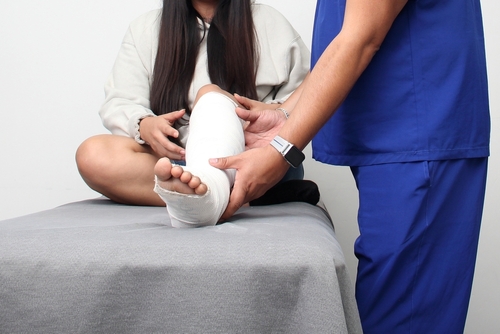Understanding Broken Bones and Their Impact
Broken bones, or fractures, can significantly affect your daily life. They limit mobility and can lead to severe acute pain. Understanding the types of fractures and their implications is crucial for effective recovery. When a bone breaks, it disrupts the normal structure of the musculoskeletal system. This can happen due to various reasons, such as accidents, falls, or sports injuries. In some cases, fractures may require orthopedic surgery to ensure proper healing and restore function. Each fracture type presents its own set of symptoms and healing challenges.
For example, a stress fracture often occurs from repetitive impact, common among athletes. In contrast, a comminuted fracture results from high-impact trauma, causing the bone to shatter into several pieces. Recognizing these differences is vital for proper diagnosis and treatment.
The healing process for broken bones varies depending on the type and severity of the fracture. Some may heal with conservative methods like casts or splints, while others may require surgical intervention. Proper medical attention is essential to ensure that fractures heal correctly and to minimize the risk of complications.
At Apex Orthopedics Rock Hill SC, specialists provide comprehensive care for fractures, ensuring patients receive the best treatment tailored to their condition. Whether through non-surgical options or advanced orthopedic surgery, receiving the right care is key to a full recovery.
In summary, understanding broken bones and their impact helps in making informed decisions about medical care. If you suspect a fracture, seek prompt medical attention. Early diagnosis and treatment can lead to a smoother recovery journey.
Definition and Causes of Broken Bones
A broken bone, also known as a fracture, occurs when a bone in the body is subjected to more force than it can withstand, causing it to break or shatter. This can happen due to various reasons, including:
- Trauma or Injury: Accidents such as falls or car crashes can exert significant force on bones, leading to fractures.
- Sports Injuries: Sudden twists, bends, or impacts during sports activities can result in broken bones.
- Stress Fractures: These occur due to repetitive stress on a bone, often seen in athletes who engage in high-impact sports.
- Osteoporosis: This condition weakens bones, making them more prone to fractures even with minor stress or falls.
- Medical Conditions: Certain conditions like osteogenesis imperfecta or cancer can compromise bone strength, increasing the risk of fractures.
It’s essential to seek immediate medical attention if you suspect you have a broken bone. Prompt treatment can help prevent complications and promote proper healing, ensuring you get back to your daily activities as soon as possible.
Why Choose an Orthopedics Rock Hill SC Specialist for Broken Bones?
When you experience a broken bone, it’s crucial to get the right care. An orthopedics Rock Hill SC surgeon offers targeted expertise in diagnosing and treating fractures. An orthopedic specialist offers targeted expertise in diagnosing and treating fractures. Unlike a general practitioner or an emergency room, orthopedic specialists focus exclusively on the musculoskeletal system, which includes bones, joints, and muscles. This specialized knowledge allows them to provide a more accurate diagnosis and tailored treatment plan for your specific injury.
Choosing an orthopedic specialist means you benefit from advanced training and experience in handling various types of fractures. Whether it’s a simple bone break or a more complex fracture, these specialists are equipped to assess the severity of your injury and recommend the best course of action. They utilize the latest technology for imaging and diagnostics, ensuring that you receive detailed insights into your condition.
Emergency Room vs. Orthopedic Specialist: Making the Right Choice
In urgent situations, you may find yourself at an emergency room. While ERs are essential for immediate treatment and stabilizing your condition, they often focus on short-term care rather than long-term treatment. An orthopedics Rock Hill SC specialist, on the other hand, will conduct a thorough evaluation and create a comprehensive treatment plan that addresses both your current symptoms and future recovery goals.
Additionally, orthopedic specialists are well-versed in the latest treatment options, including both nonsurgical and surgical interventions. They can guide you through the healing process and help manage any pain or complications that may arise. This level of care is vital for ensuring that your broken bones heal properly, allowing you to regain mobility and return to your daily activities as soon as possible.
In summary, choosing an orthopedics Rock Hill SC specialist for your broken bones means opting for focused expertise, advanced treatment options, and a commitment to your long-term recovery. When you prioritize specialized care, you set yourself on the path to optimal healing and improved quality of life.
Types of Broken Bone Fractures and Their Symptoms
Understanding the different types of fractures is crucial when dealing with broken bones. Acute pain often accompanies fractures, necessitating prompt medical attention to alleviate discomfort and promote recovery. Each type of fracture comes with its own set of symptoms and treatment requirements. Here’s a breakdown of the most common types of bone fractures.
Stress Fracture and Sports Injuries
Stress fractures are tiny cracks in the bone, often caused by repetitive force or overuse, especially in athletes. Common symptoms include localized pain that worsens with activity and may improve with rest. These fractures are often found in weight-bearing bones, such as the foot or leg. If you’re active in sports, be aware of the signs and seek medical attention if pain persists.
Transverse, Oblique, and Comminuted Fractures
Transverse fractures occur when a bone breaks straight across, while oblique fractures have an angled pattern. Comminuted fractures involve the bone being shattered into multiple pieces. Symptoms typically include severe pain, swelling, and an inability to move the affected area. These fractures often require more extensive treatment, including possible surgery.
Greenstick and Pathologic Fractures
Greenstick fractures are incomplete breaks, commonly seen in children whose bones are still flexible. They may present with pain and swelling but often do not cause complete loss of function. On the other hand, pathologic fractures occur due to underlying conditions, such as osteoporosis or cancer. Symptoms can vary widely depending on the bone affected and may include pain, swelling, and deformity.
Recognizing the type of fracture is essential for proper diagnosis and treatment. If you suspect a broken bone, consult an orthopedics Rock Hill SC specialist for a thorough evaluation and appropriate care.
Diagnosing Broken Bones: The Role of Advanced Imaging
Importance of X-rays, CT Scans, and MRIs
When a broken bone is suspected, accurate diagnosis is crucial. Advanced imaging techniques play a vital role in identifying the type and severity of the fracture. X-rays are often the first step in this process. They provide clear images of bone structure, allowing orthopedics Rock Hill SC specialists to see fractures and assess alignment.
However, X-rays may not always reveal the full extent of an injury. In such cases, CT and MRI scans come into play. CT scans offer detailed cross-sectional images, which can help in identifying complex fractures or injuries involving joints. MRIs, on the other hand, are particularly useful for detecting soft tissue damage, including injuries to ligaments and cartilage that may accompany a bone break.
Understanding the role of these imaging techniques is essential for effective treatment planning. Proper diagnosis leads to a correct treatment plan, which is crucial for recovery. If you suspect you have a broken bone, seeking immediate medical attention and utilizing advanced imaging can significantly impact your healing process.
Treatment Options for Broken Bones
When dealing with broken bones, selecting the right treatment is crucial for effective recovery. There are two primary categories of treatment: nonsurgical and surgical interventions. Each option caters to different types of fractures and patient needs.
Nonsurgical Treatments: Casts, Splints, and Physical Therapy
For many fractures, nonsurgical treatments can provide adequate healing. Casts and splints are commonly used to immobilize the affected area, allowing the bone to mend properly. These devices help limit movement and provide support, which is essential during the healing process.
Physical therapy often follows the initial immobilization period. This stage focuses on regaining strength and flexibility in the affected limb. A tailored physical therapy program can help restore function and reduce the risk of future injuries. Patients who engage in physical therapy typically experience faster recovery times and improved overall mobility.
Surgical Interventions: Internal Fixation and Hip Surgery
In certain cases, surgical intervention by an orthopedics Rock Hill SC surgeon may be necessary. This is particularly true for severe fractures that cannot heal properly with nonsurgical methods. Internal fixation is a common surgical procedure used to stabilize broken bones. During this procedure, orthopedic surgeons use metal plates, screws, or rods to secure the bone fragments together. This approach promotes proper alignment and supports the healing process.
Hip surgery may also be required for fractures in the hip area, especially in older adults. This type of surgery often involves either repairing the fracture or replacing the damaged joint. The choice depends on the severity of the injury and the patient’s overall health.
In conclusion, the treatment for broken bones varies based on the fracture type and individual circumstances. Consulting with an orthopedic specialist will help determine the most effective treatment plan tailored to your specific needs.
The Healing Process: What to Expect
How Broken Bones Heal and the Importance of Follow-Up Care
When a bone breaks, the body initiates a natural healing process. Understanding this process is crucial for recovery. Initially, a fracture leads to inflammation. This response is the body’s way of protecting the injury. Blood vessels around the broken bone will constrict to minimize blood loss and then dilate, allowing essential nutrients and cells to reach the area.
Over the next few days, a soft callus forms, bridging the gap between the broken ends of the bone. This callus is made of collagen and cartilage, providing a temporary structure. As healing progresses, the body begins to replace this soft callus with hard bone. This phase can take several weeks depending on factors such as age, overall health, and the type of fracture.
Physical therapy plays a vital role during recovery. Engaging in guided exercises helps restore mobility and strength. It’s essential to follow the treatment plan provided by your orthopedics Rock Hill SC specialist. Regular follow-up appointments are necessary to monitor healing and adjust the treatment plan as needed.
Additionally, be vigilant about any signs of complications. Swelling, severe pain, or changes in skin color around the fracture site may indicate issues that require immediate medical attention.
In summary, the healing of broken bones is a multi-step process. With proper care, most fractures heal effectively, restoring function and mobility. Always consult your orthopedic specialist for tailored advice and to ensure a smooth recovery.
Prevention and Maintenance of Bone Health
Preventing future injuries and maintaining bone health is crucial to reducing the risk of broken bones. Here are some tips to help you achieve this:
- Regular Exercise: Engage in weight-bearing activities like walking or running to strengthen your bones.
- Healthy Diet: Maintain a diet rich in calcium and vitamin D, which are essential for bone health.
- Avoid Smoking and Excessive Alcohol: These habits can weaken bones, making them more susceptible to fractures.
- Protective Gear: Wear helmets, knee pads, and other protective gear when engaging in high-risk activities.
- Good Posture and Body Mechanics: Practice good posture and body mechanics to reduce the risk of falls and injuries.
By following these tips, you can help maintain strong and healthy bones, reducing the risk of broken bones and other orthopedic-related issues.
Preventing Future Injuries and Maintaining Bone Health
Preventing future injuries and maintaining bone health requires a combination of lifestyle changes and medical interventions. Here are some additional tips to help you achieve this:
- Consult an Orthopedics Rock Hill SC Specialist: Consider consulting with an orthopedic specialist or sports medicine physician to develop a personalized exercise program that suits your needs and goals.
- Incorporate Physical Therapy: Physical therapy can improve flexibility, strength, and range of motion, helping to prevent future injuries.
- Proper Lifting Techniques: Use proper lifting techniques and body mechanics to reduce the risk of injury.
- Stay Hydrated and Eat a Balanced Diet: Proper hydration and a balanced diet support overall bone health.
- Consider Supplements: Calcium and vitamin D supplements can support bone health, but always consult with a healthcare professional before starting any new supplements.
By taking proactive steps to prevent future injuries and maintain bone health, you can reduce the risk of broken bones and other orthopedic-related issues, ensuring a healthier and more active lifestyle.
When to Seek Medical Care for a Suspected Broken Bone
Signs and Symptoms That Require Immediate Attention
Recognizing the signs of a broken bone is crucial for timely treatment. If you suspect a fracture, certain symptoms should prompt you to seek medical care without delay.
- Severe Pain: If you experience intense pain that does not subside with rest or over-the-counter pain medication, it may indicate a serious injury.
- Swelling and Bruising: Noticeable swelling around the area of injury, along with bruising, can signal a fracture. This is especially true if the swelling worsens over time.
- Deformity: If the affected area appears misshapen or out of alignment, this could be a clear sign of a broken bone.
- Inability to Move: Difficulty or inability to move the affected limb or joint can suggest a fracture. If you cannot bear weight on a leg or walk normally, it’s time to seek help.
- Numbness or Tingling: These sensations may indicate nerve damage associated with a fracture. If you feel numbness or tingling in the area, don’t hesitate to get checked.
- Open Wounds: If there is an open wound near the injury site or bone protruding through the skin, this requires immediate medical attention to prevent infection and other complications.
If you notice any of these symptoms, it is vital to visit an urgent care center or an orthopedics Rock Hill SC specialist promptly. Immediate treatment can stabilize the injury and is crucial for further evaluation and long-term management. Early diagnosis and treatment can significantly affect the healing process and overall recovery. Don’t ignore the signs; your health is paramount.
Apex Orthopaedics Spine & Neurology: Your Partner in Recovery
When you experience a broken bone, having a dedicated and knowledgeable team by your side is crucial. At Apex Orthopaedics Spine & Neurology, we specialize in providing comprehensive care tailored to your specific needs. Our orthopedics Rock Hill SC specialists understand the intricacies of broken bone injuries and are committed to guiding you through every step of your recovery journey.
Comprehensive Care: Orthopedic Surgery, Pain Management, and More
Our approach combines advanced medical services with compassionate care. Whether you require orthopedic surgery, pain management, or physical therapy, our experts will develop a treatment plan that addresses your unique situation. We utilize the latest technology to accurately diagnose and treat your injury, ensuring that you receive the best possible care.
Convenient Access: Same & Next Day Appointments, Telemedicine Visits
Accessibility is a priority at Apex Orthopaedics. We offer same and next-day appointments, along with telemedicine visits for your convenience. This means you can receive immediate medical attention without long waits. Our goal is to make your recovery process as smooth as possible, allowing you to focus on healing.
No Out-of-Pocket Expenses: Insurance and Payment Options
Additionally, we understand that financial concerns can be overwhelming. That’s why we offer no out-of-pocket expenses for our patients, working directly with your insurance to cover necessary treatments. We believe that quality care should be accessible to everyone, regardless of financial circumstances.
Choosing Apex Orthopaedics Spine & Neurology means partnering with a team that prioritizes your health and recovery. Trust us to provide the expert care you need to heal and regain your strength.
Schedule Your Appointment with Apex Orthopaedics
Booking an appointment with Apex Orthopaedics is straightforward and convenient. Whether you are a new patient or returning for follow-up care, we are here to assist you.
How to Book an Appointment With Apex Orthopaedics
You can easily schedule your appointment online through our user-friendly portal. Simply select a date and time that works for you. Our team is ready to help you with any questions you may have about your visit.
Compassionate and Expert Care for New and Returning Patients
At Apex Orthopaedics, we pride ourselves on providing compassionate care. Our team of orthopedics Rock Hill SC specialists is dedicated to ensuring that every patient receives the attention they need. Whether you are dealing with a broken bone, chronic pain, or sports injuries, we are committed to your recovery.
Contact us today to take the first step toward healing 704-412-3045






